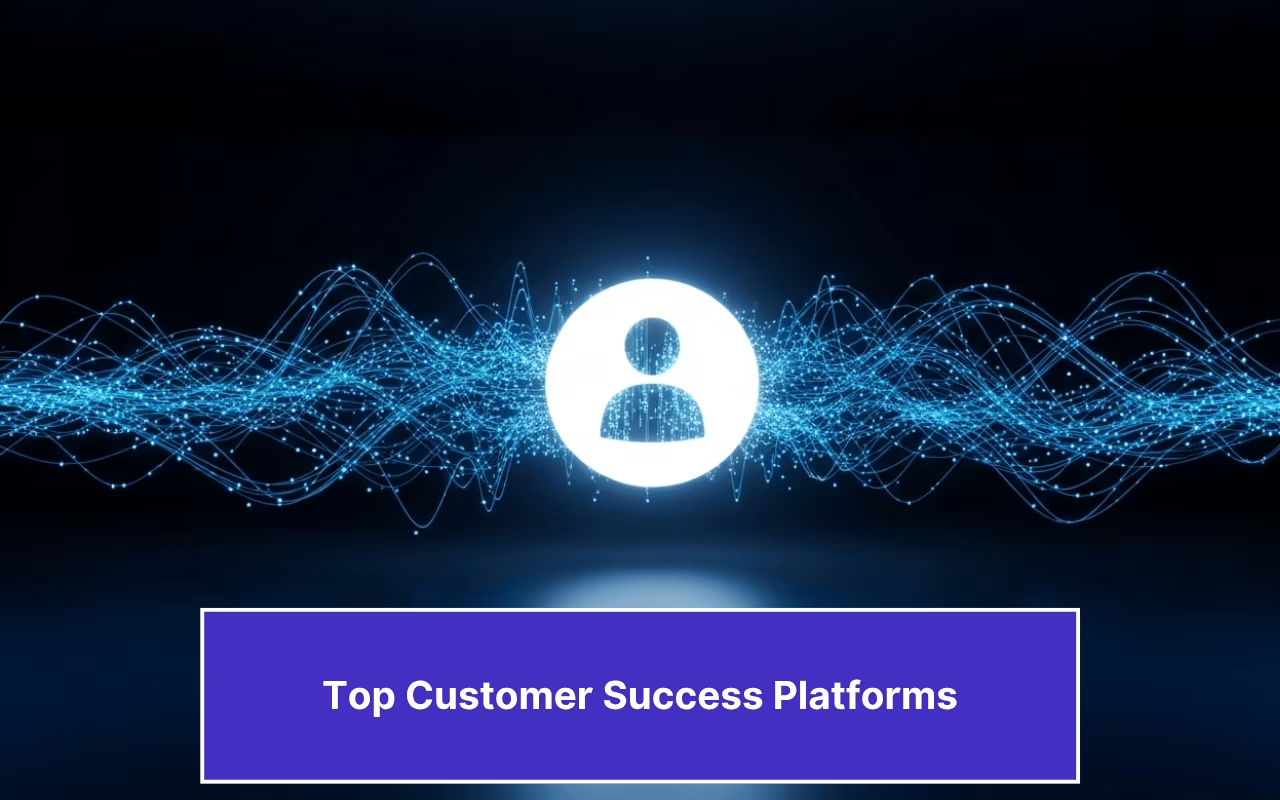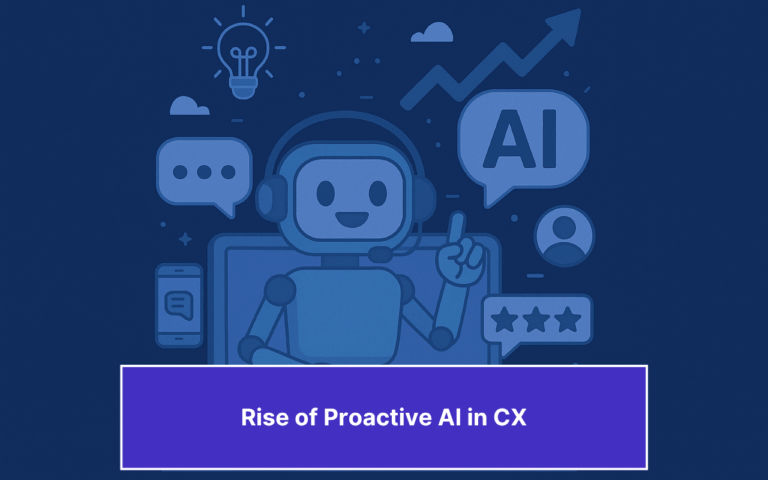Updated on August 14, 2024
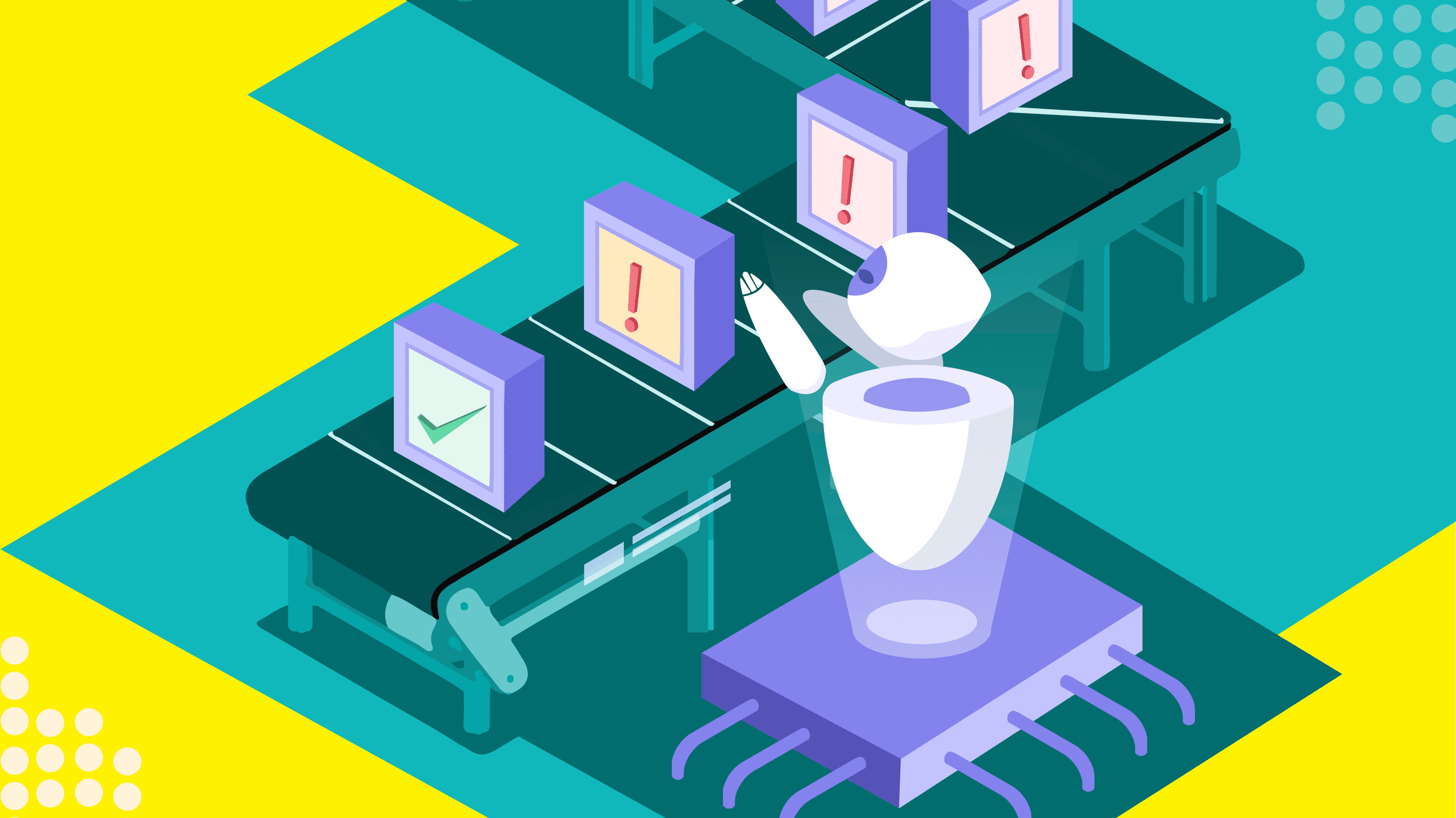
Brands today don’t compete over just the products but how they choose to sell them and how fast they resolve their customer’s query. An automated system can play a crucial role in selling the experience of buying a product from a particular brand. If you are manually answering all your customer queries, you are doing it wrong.
Even small businesses are automating as much as possible to offer excellent customer support. Specially the new age software companies like Lovable, Bolt, Replit who have very less employee count and higher revenue. Companies familiar with automation upsides have the upper hand over the ones still skeptical about it. You don’t have to transform your entire service plan. You can selectively choose AI-powered customer support automation to fit into your strategies.

What is Customer Service Automation?
“Customer Service Automation is the strategic use of intelligent technologies like AI, machine learning, and robotic process automation to take customer interactions to the next level.
Customer Service Automation involves automating routine tasks, providing self-service resources, anticipating customer needs through data analysis, and delivering efficient and personalized customer service.”
The aim of customer service automation is to keep human intervention to a minimum, while at the same time retaining the “human” touch.
Why Should You Prioritize Automating Customer Service?
The customer demands are ever-increasing; chances are, you are often short on human resources to handle them all. Additionally, over half of the customer queries are repetitive, and automation will save both the time and energy spent by human resources. Let’s consider the advantages of automating customer support one at a time.
1. Automate Simple and Repetitive Tasks
A complete team of customer support agents has to deal with the same tasks repeatedly daily. These tasks range from manual tagging to routing different issues to different agents. Furthermore, there is sorting, answering the standard set of questions, and more.
A simple bot could take over for a standard set of questions instead of an agent typing the same content all day long. In addition to responding to customer queries, a bot can also collect feedback at the end of the interaction. Since it is a part of the conversation, the customer is more likely to respond to the survey. This allows human agents to save their time and energy on more complex queries.
Additionally, a simple text classification API could classify incoming conversations. The tool can prioritize customer issues and help save time. Furthermore, a text extractor can be employed to analyze data and dig up information like customer contact details and other relevant keywords.
2. Offer Proactive Response
Time is a “make or break” factor for your customer support strategies. The quicker you respond, the better. However, humans have limits, and it is not always practically possible to be quick on the uptakes. Automating this task goes a long way in increasing customer satisfaction. You can make a chatbot that responds immediately and even offer a list of suggestions for customers to pick. Usually, standard queries get resolved then and there. In the case of complex issues, the bot can connect to a human agent for interaction.

Take Mastercard, for example. Their Facebook Messenger bot makes it easier for customers to check recent transactions. It allows you to review account information and generate a purchase history list.
The merchant bot also enables Masterpass within chats that allow direct merchant-customer chats. The customers can make the payment without leaving the conversation.

3. Reduce Cost
Employing efficient customer support requires time and many resources. On the other hand, an AI-powered system (such as a Chatbot and related CRM integrations) requires a one-time configuration and setup. Also, everyday use trains the Machine Learning model to improve efficiency on wever-increasing sampling size. Moreover, the cost of maintaining such software is a lot cheaper than maintaining an entire team.One can attribute a massive chunk of the queries to FAQs. If there is a bot present for them, your savings will increase considerably.
You can re-invest the money you save on scaling the team and deploy them in handling more challenging work tasks.
As per an IBM study, businesses spend over $1.3 trillion on 265 Billion customer service calls. As per Chatbots Magazine, chatbots can reduce service costs by 30%.

4. Improve Efficiency for Both Agents and System
With automation, there is less room for human error. If the chatbot fails to answer a customer query, it can transfer the problem to a human agent. Since the routing of complex customer queries is automated, the query is always assigned to the person with the appropriate expertise.
As mentioned earlier, the system always gets better with a higher volume of queries over a period. For instance, customer service chatbots are the most preferred customer service automation systems. With chatbots, you will know where the chatbot has failed, allowing you to feed the data back into the system to prevent such service failures in the future. If you have an automated system, the machine learning algorithms in place enable pattern recognition, improving the system’s performance.
5. Deliver Personalization
Contrary to the belief that it doesn’t get more personal than a human to human interaction, automation can offer a lot when it comes to personalization. A human agent cannot possibly remember customer details let alone previous interactions with them. A chatbot, on the other hand, is capable of doing both. Automation has, indeed, improved customer experience by exploiting caveats left by human inefficiencies.
If customers have already logged into the system, the chatbot can use the historical data and come up with resources to assist them. Additionally, if customers are stuck on an issue from the last time, a chatbot can easily pull up their records and help solve their issue efficiently.
Automate customer queries, streamline support workflows, and boost efficiency with AI-driven email ticketing from Kommunicate!Best Practices for Automating Customer Service
1. Selective Automation
When it comes to customer support, your primary objective is to avoid alienating the customers. To cover all the bases, you have to be selective about the automation you choose. For instance, you can look at automating customer service aspects such as repetitive queries, knowledge bases, login, check out, and thank you pages. These tasks combined take a lot of time and energy that you can utilize on something more substantial.
Furthermore, today’s digital customers like to be in control of their user experience and providing them self-service options gives them the opportunity to skip the wait for an agent and solve minor issues themselves. Since self-service portals minimize time and effort for both the customer and agent, it is a win-win situation that helps boost your bottom line.
When it comes to choice, you can choose not just the tasks,but also the automation based on the kind of customer as well.
From a customer’s point of view, consistency is vital. Pick the channels that suit both you and your customers and automate them. Do not waste your time and resources on a deadbeat platform.
2. Omnichannel Service
If you are offering different channels, your customers expect you to be equally responsive to all of them. However, you cannot manually attend all the queries on all the platforms. Consolidating all your service channels to provide a consistent user experience is a great way to make your automated services collaborative and more efficient.
A comprehensive customer support software is the most efficient option to consolidate everything on a single platform. When all the customer queries are stacked on a single dashboard, you can minimize the time taken to scale your support resources.
While merging channels in the process of automation, make sure that your customer support automation and human representatives are in sync. If the issue reaches the human agents after failed attempts by bots, customers might have to repeat themselves. This is when the experience starts to deteriorate, and your omnichannel strategy would take a hit. To avoid that situation, make sure that the processes you automated can integrate with each other.
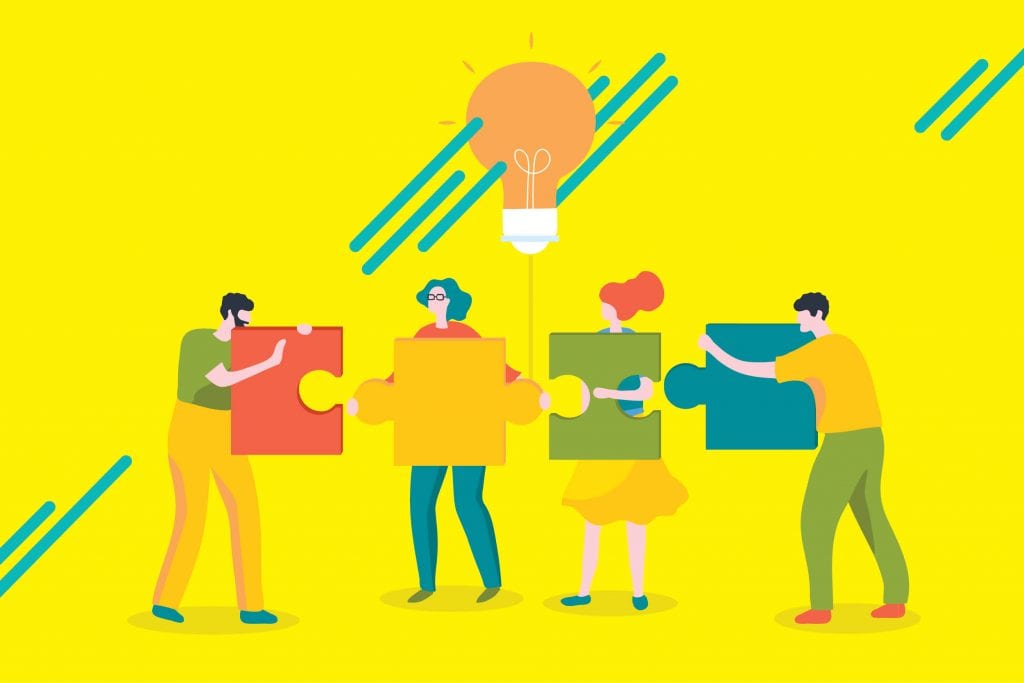
An agent should get hold of all the relevant customer information from all the previous platforms on a single interface. These could be social media messages, phone calls, emails, live chat, and support tickets. With everything in one place, agents can assist quickly and effectively.
3. Keep Testing and Ask for Feedback
Customer service automation should be appealing to your customers, team members and your business as a whole.. If any stakeholder is not benefitting from this technology, you should reevaluate your strategy.
One other thing to consider while automating customer service is to collect regular feedback. It’s vital to analyze the sentiment of your audience against your services. The customer experience you offer is a direct indication of product popularity. So, make sure you keep your audience in the loop and work on the feedback you receive.
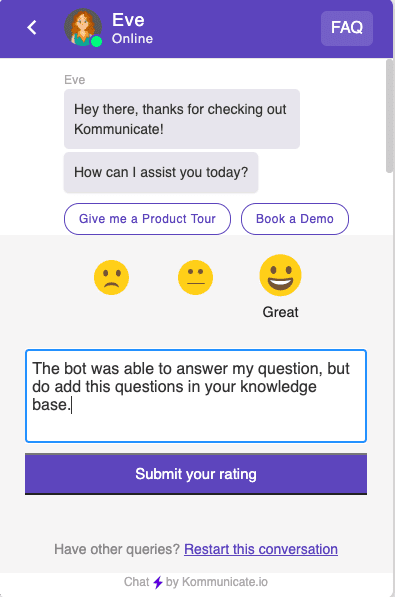
Additionally, keep track of how the audience interacts with the changes. The analytics will help you decide what level of automation to keep. Always check with the support team to know what works for them.
4. Cater to All Your Customers
Different customers have different requirements and separate approaches to online browsing. You have to automate services in a way that caters to all your customers, without leaving out any demographic. For instance, youngsters usually prefer self-service. So, instead of a bot popping up in their faces, you might want to automate FAQs and smart knowledge bases.
For the first time users who are having a hard time navigating through the website for products, you can send a proactive message after a specific time interval.
5. Automated Follow-ups
It takes more than a functional website to convert a potential customer to a paying one which usually doesn’t happen on the first customer visit. Hence, you need to have excellent follow-up skills to make a compelling sales pitch. The task is not always up to a human agent. Apart from the fact that it could be a tedious job, the leads often dry up in a matter of hours.
It is not humanly efficient, even if possible that these leads are followed up on time and helped with making a purchase. An automated follow-up handles this issue remarkably well.
Even sending a customer survey in the chat window after every interaction can help with the same.
6. Seamless Transfer Between the Automated System and Human Agents
Chatbots and human agents must work in lockstep for smooth customer support. If a chatbot accurately responds to the initial queries and then fails to route to a human agent for complex ones, the entire customer experience effort will take a hit. A seamless chatbot to human handoff is vital in an automated system.
Don’t give your customers a chance to wait. Your system must be efficient enough to assign the right agent in time. After resolving the issue, the human agent can again transfer to the bot to collect feedback.
Here’s an example of what not to and what to do:
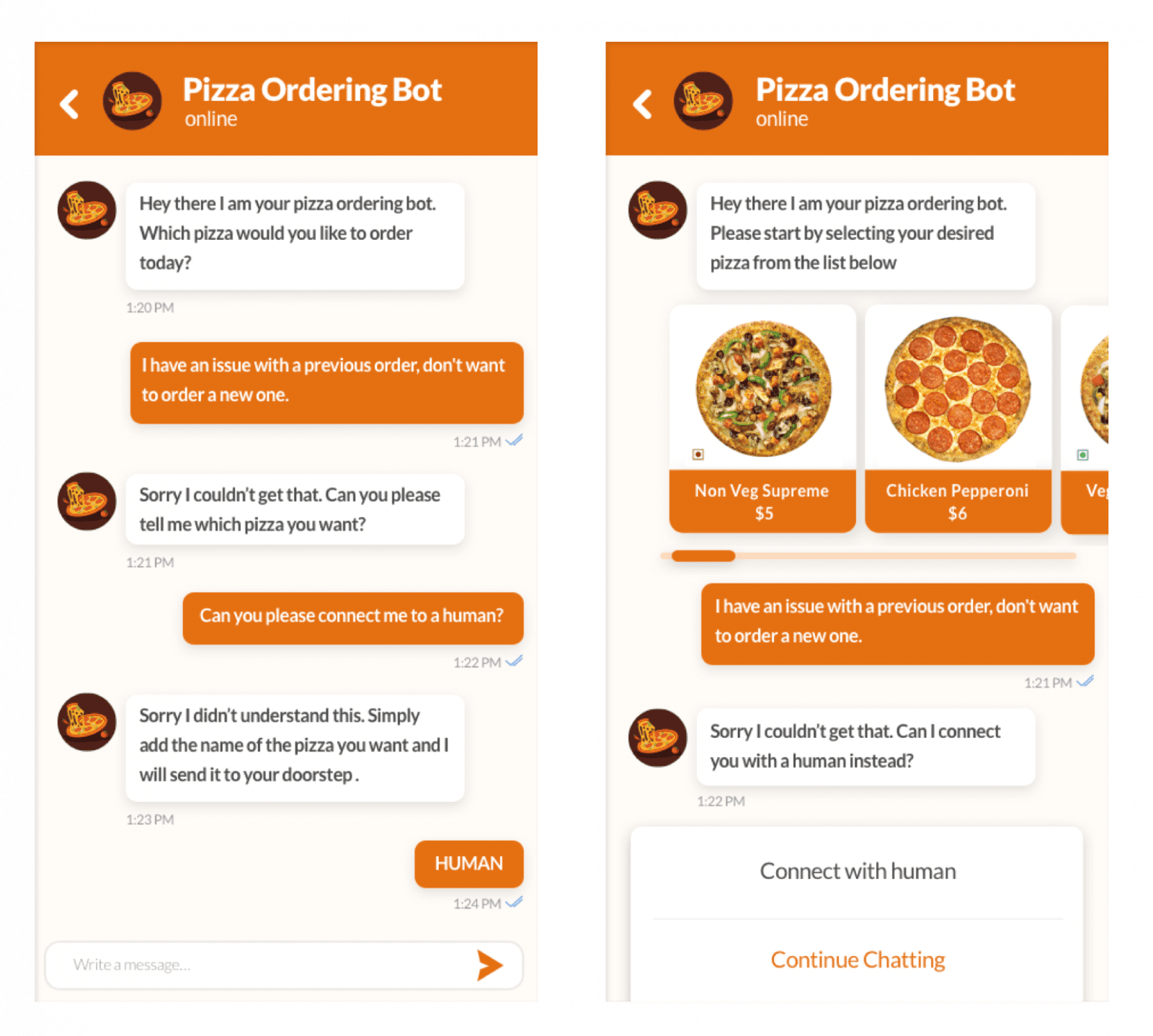
How to Automate Customer Service – 5 Steps
Step 1 – Implement Conversational AI and Chatbots
The first step is to deploy AI-powered virtual assistants and chatbots to that leverage natural language processing to understand customer queries and respond to them. These chatbots are available 24/7, and must be seamlessly integrated into the business’s website, mobile app or messaging platforms.
Step 2- Build a Comprehensive Self-Service Portal and Knowledge Base
The next step is to create searchable knowledge bases with FAQs, how-to guides, tutorials, etc, that will help customers find answers to queries independently. This will reduce the dependency on live agents and promote independence among customers.
Step 3 – Automate Routing and Request Handling
Capturing customer inquiries through automated ticketing systems is the next step in the process. These tickets must then be intelligently routed to the appropriate support team or agent. Streamline the triage process and ensure faster response times.
Step 4 – Leverage Machine Learning
As you collect more and more customer data, there starts to emerge behavioral patterns and preferences. Using machine learning algorithms, you can provide personalized recommendations and targeted support content. Businesses must also use predictive analytics to anticipate customer needs proactively.
Step 5 – Enable Omni Channel Integration and Continous Optimization
The final step is to ensure a seamless and consistent experience, across multiple support channels, allowing customers to switch between channels without losing context. Customer feedback must be continuously reviewed, and data analysis must be done to identify areas of improvement.
Tools for Automating Customer Service
Artificial Intelligence has been around for a while, with its reach increasing more than ever. The customer service domain has seen significant improvements due to AI-driven innovation, transforming customer service in AI by enhancing response accuracy, personalizing interactions, and streamlining support processes. It happens to be the field that has leveraged its services the most. Depending on the size and outreach of a business, there are multiple options available. Let’s talk about these tools in detail.
1. Natural Language Processing (NLP)
NLP refers to the part of computer science, specifically AI, that deals with the capability of computers to understand spoken words and text just like a person. NLP is used to run programs that are used in translation, executing a function based on a voice command and even to provide a summary of large volumes of text in real-time.
It doesn’t matter which route the customer opts to reach out to you, NLP is always in play. From phone calls, emails, text messages to social media, NLP plays a critical role in the process. The underlying technology ensures the accuracy of AI-powered services like virtual assistants.
We can make use of NLP for empathetic customer service messaging by gauging the customer’s emotional state. Business to customer (B2C) messages have gotten more effective over time. You can leverage NLP by responding to customers in a way that suits the situation on an emotional level. For instance if a customer is angry or frustrated, NLP can be used to approach the customer with an appropriately caring and gentle tone of messaging. Such intuitive responses define the effectiveness of NLP.
For example, our chatbot builder Kompose is built over powerful NLP to support smooth conversation flow. Additionally, it comes with built-in small talk intents, which can handle generic questions seamlessly. This helps in catering to generic experimental users, who, out of sheer curiosity, ask generic questions to chatbot such as:
- Who are you?
- You are annoying me.
- Nice to meet you
- How was your day?
- Are you human, et cetera.
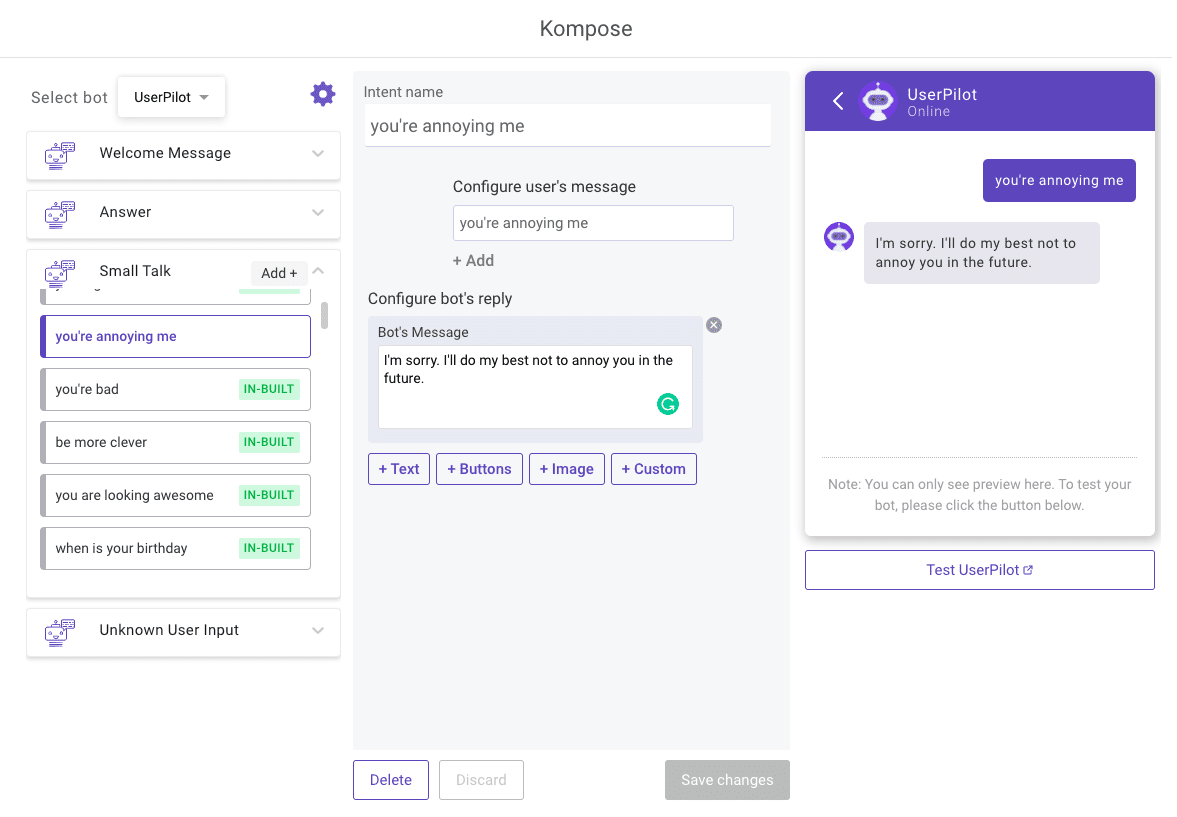
2. Chatbots and AI-Powered Automation
The introduction of the live chat was a significant development in customer support. Instead of waiting for the agents to call back and reply to emails, people could just directly reach out to a support executive through chat. Live chat was the first leap towards real-time customer service.
However, live chat is still far from covering all the incoming requests. Somewhat automated, live chats still require human agents to take charge behind the dashboard. Furthermore, 24×7 support is almost impossible even if you scale your customer support team. Not to mention, the more you extend the team, the more it adds to incurred cost.
The issues here, collectively, can be resolved by an AI-powered chatbot. Chatbots have established themselves as a more dependable support automation form eliminate the time-constraint that comes with human agents. A chatbot can respond to customer queries all day long without a break.
A chatbot can usually answer the common queries, and in case of something complex, it can loop in the human agent. Chatbots participate in a hybrid conversation, allowing the machines to learn from the human reps and vice-versa. The more queries a chatbot handles, the more efficient it gets making it beneficial both the machines and staff.
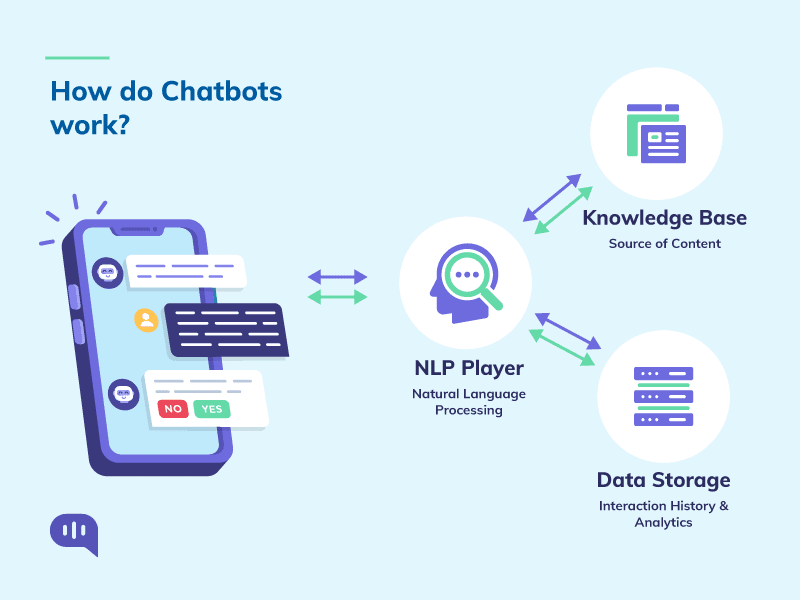
Moreover, chatbots also play a crucial role in human-to-human interaction. Based on the data collected, they can route the customers to the best-suited human representative. Based on business requirements, there are all kinds of chatbots available in the market. Simple chatbots are easy to deploy and integrate.
If you consider a chatbot automation solution, check for all the messaging platforms that integrate with it. A good chatbot will work across your website, applications, SMS, Facebook messenger, and other native platforms.
3. Complete Customer Service Software
Customer service software is usually programmed to internally route the incoming queries to the most suitable agent available. The systems have developed over time to cater to the audience coming from all the different platforms. The omnichannel approach has become quite the rage among the brands. Customer service software essentially puts all the conversations from various platforms in a single dashboard.
While implementing customer service automation, the developers are focused on intelligent technology that can route the conversations in the best possible way. The hybrid system offers a seamless working environment for the bots and agents. Virtual assistants, paired with human representatives, create an efficient support system.
If a company has a large support team, equipping them with such a software would be the right choice. The leading software in the market today comes with all the major integrations required for customer support and service. Apart from responding to customer queries, complete support software will also allow you to track the website’s visitors. This helps the team be proactive. Furthermore, you can also look at user analytics on the dashboard and update your strategies in real-time.
Customer service software also helps tackle customer abandonment issues.
Cart abandonment rate, in some cases, can go as high as 80%.
Most of these are the results of poor customer service and untimely responses. For medium and large-sized businesses, customer support software is an ideal tool for addressing customer queries and resolving them.
4. Automated Responses
The primary goal of creating automated responses is to take the load off human agents while dealing with regular queries. These are suggested articles or recommended answers relevant to customer queries before they connect with an agent. These recommendations are based on AI algorithms. Simply put, they make for an intermediate technology between a self-search knowledge base and an automated chatbot.
This technology is arguably less engaging than a chatbot, but it can be highly effective. Merging the two would undeniably make the system more efficient.
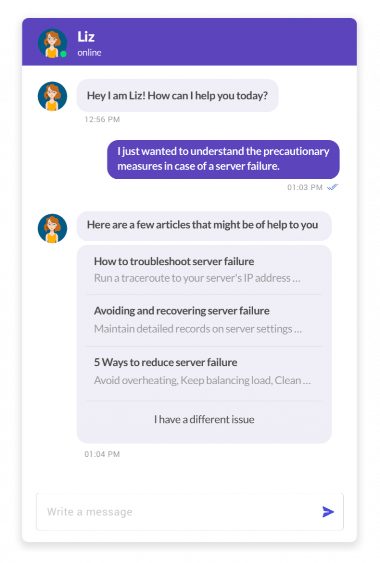
5. Agent Assist
The technology can either be a part of a complete customer support software or a standalone technique for selective automation. The goal is to maximize the efficiency of human agents by automating mundane tasks.
One such task could be optimizing the ticket route that uses previously gathered data to assign tickets to either chatbots or the most suited agent available. Furthermore, functions such as tagging ticket assignment, scenario automation, creating quick replies, ticket prioritization, and note-making could also be automated to make room for complex customer queries.
6. Smart Knowledge Base
Many websites use self-serving knowledge bases, hoping customers will find what they seek. While it’s a standard approach, you can choose to make these knowledge bases smart so the customer finds solutions to their queries quickly and avoid getting frustrated.
These smart knowledge bases use AI to route the customers to the most relevant articles. In addition to helping customers, smart knowledge bases empower the human agents as well. While interacting with customers, they can use these articles to respond faster and more efficiently.
Better yet, you can connect your knowledge-base to chatbots. The chatbot can further match the data from the user’s query and fetch answers from your knowledge base.
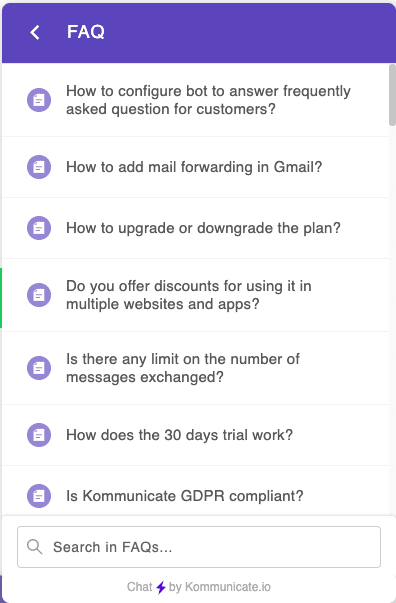
Better yet, you can connect your knowledge-base to chatbots. The chatbot can further match the data from the user’s query and fetch answers from your knowledge base.
7. Create Your Own Automation System
If you are not interested in complete software or even a fully automated chatbot, you can always create your own automation system using specific tools. These could be APIs, data transcript services, webhooks, etc.
Services like Wit, IBM Watson, and DialogFlow allow you to create chatbots across multiple platforms. Amazon Connect enables you to set up a voice IVR system. Selective automation can be a part of a more generous strategy for your internal team of support agents. Based on your customer demands, you can choose from any of these services and put them into action.
Let us now look at some of the benefits of automating customer service.
Benefits of Automating Customer Service
Here are some of the benefits of automating customer service.
- 24/7 availability: With AI-powered chatbots and virtual assistants, companies can provide round-the-clock support. Customers get instant help whenever they need it. For example, Walmart’s e-commerce platform, where grocery shopping is done easily, thanks to AI technology.
- Better efficiency: With automation, there is no need for agents to focus on repetitive tasks, and they can instead focus on more complex issues.
- Cost savings: When companies adopt automation, they are deflecting a majority of customer queries, reducing the need for human resources. Verizon, the telecom giant, has apparently saved $1 billion annually by implementing AI-powered chatbots.
- Scalability: When you automate systems, they can handle a sudden bump in customer volumes without compromising on the service quality.
- Improved response: Automated systems can provide near instantaneous responses, reducing the wait time for customers, and thus improving customer satisfaction. An example for instantaneous response is cloud computing services like AWS, that can instantly provision responses upon request.
How to Automate Customer Service
1. Identify Repetitive Processes
The first step is to identify repetitive, rule-based processes that can be automated. For example, Delta Airlines implemented complete automation of frequent flyer miles, reservation charges, and baggage fee calculations, which led to improved customer satisfaction.

Image credit: Delta Airlines
2. Implement Conversational AI or Chatbots
Deploy AI powered chatbots or virtual assistants that can handle routine queries or basic troubleshooting. Customers are always looking for answers for common questions, and expect businesses to be available 24/7 for them. A good example of a company that has implemented chatbots to automate its customer service is Booking.com, which integrated a travel chatbot into its Facebook messenger to handle simple customer transactions.
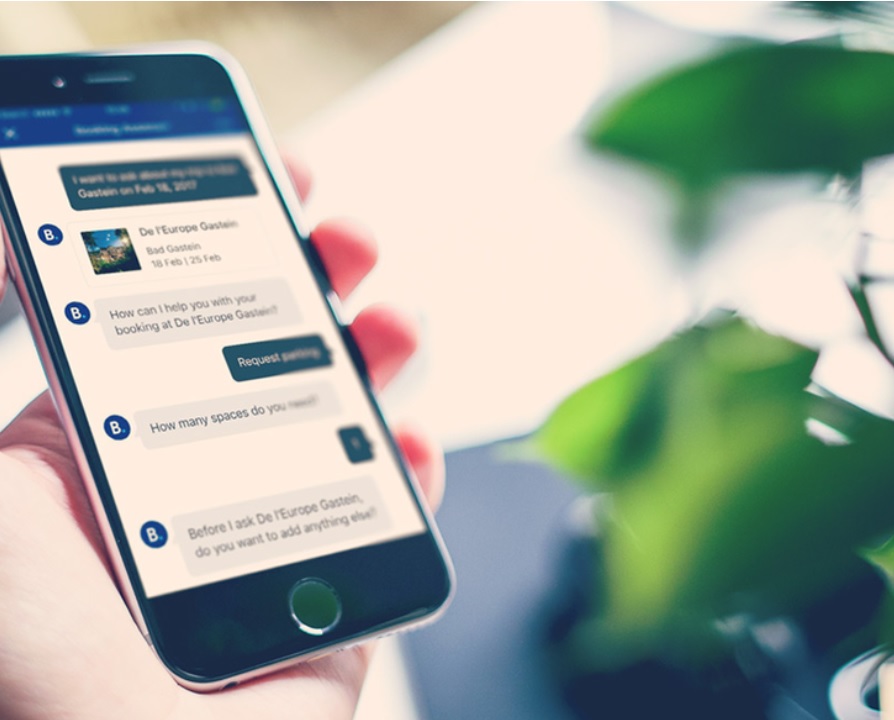
Image credit: Click-magazine
3. Build A Solid Knowledge Base
Self-service is the key to keeping the younger customers happy, according to multiple reports. One way to ensure that customers can use the product to the maximum potential is to build a comprehensive knowledge base which is searchable, and has FAQs, guides and tutorials that enable self-service.
Hubspot, for instance, has built an excellent knowledge base, where customers can search about a wide array of Hubspot products, or any other questions they may have.
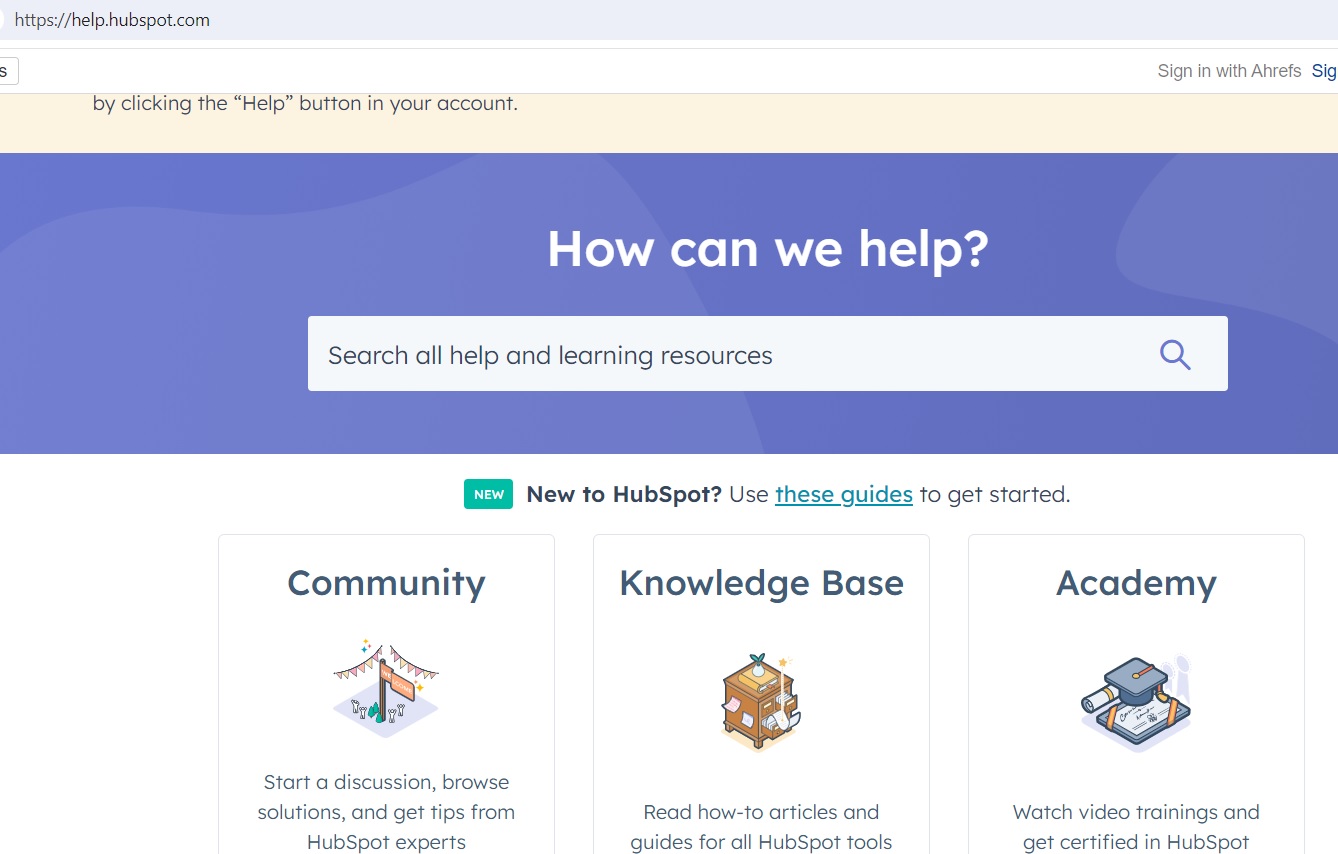
Image credit: Hubspot
4. Use RPA
Robotic Process Automation (RPA) is used to automate repetitive tasks such as information retrieval, data entry, and form filling. RPA can also automate tedious back-office processes such as updating customer records or verifying information across multiple systems.
Some of the leading RPA platforms used by enterprises include UiPath and Automation Anywhere.
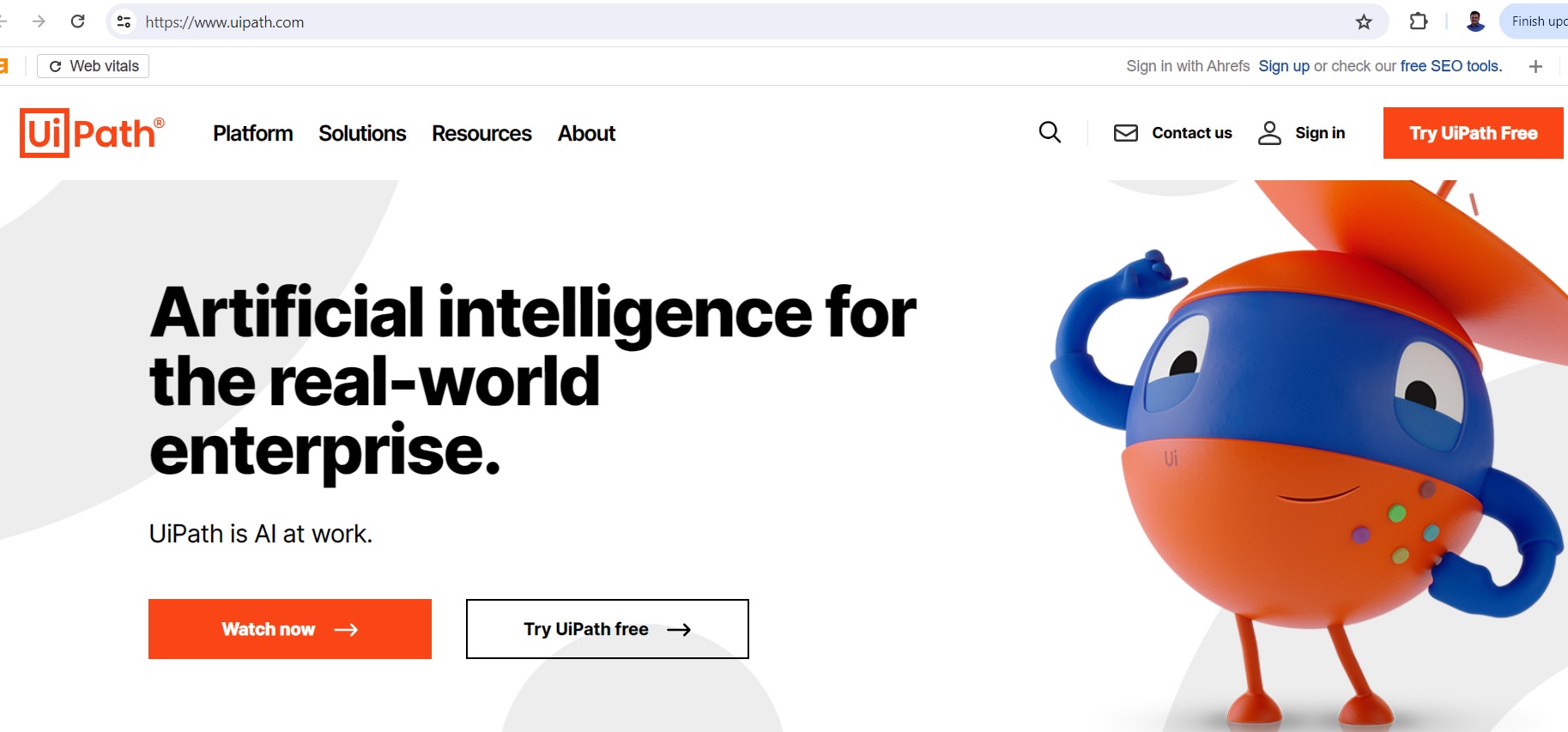
Image credit: UiPath
5. Integrate Channels
Ensure that there is a seamless omnichannel experience by integrating customer support across all the different touch points such as websites, mobile app, messaging platforms and social media.
American Express, the US bank-holding company, uses an integrated virtual assistant called “Ask American Express,” which gives customers automated support across all its major channels, including mobile app, social media, SMS and WhatsApp.
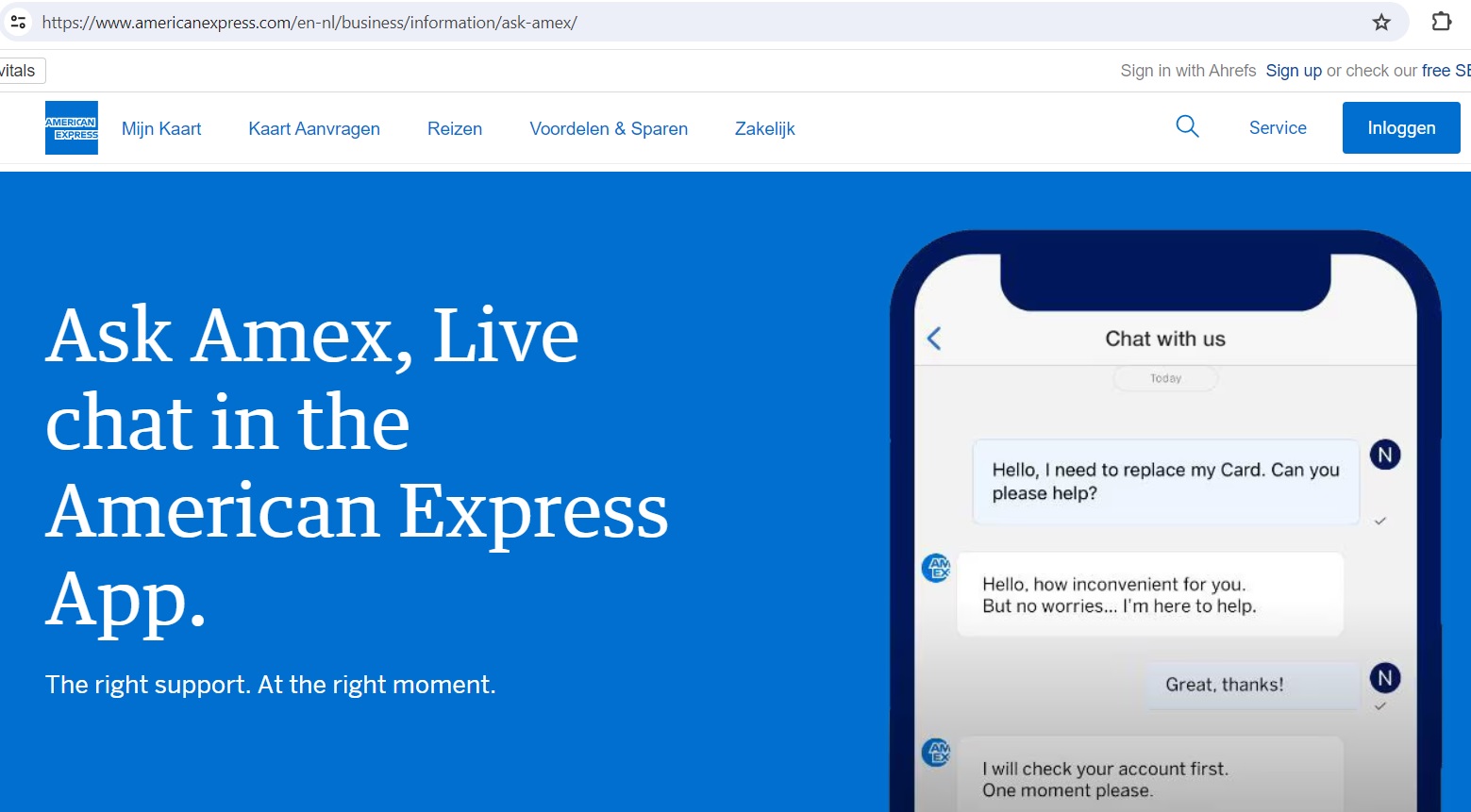
When is Automation, Not the Right Way to Go
1. When the Customer Is New to the Platform
Every customer comes with their own set of challenges, and their own reasons to choose your product. When you are in the race to automate customer service, make sure you don’t ignore one of the most important set of customers – the new acquisitions.
Your newest customers may not have a smooth onboarding process if they are always “redirected to a bot.” Chatbots can go only so far as to answering customers queries, and even though we may have advanced chatbots with NLP capabilities, many new customers would still prefer the human touch. It may not be good to implement customer service automation in these cases.
2. Customers Who Need a Lot of Hand-Holding
Customer service automation may not be the best solution for customers who are not tech-savvy, and those who need to really taught step-by-step on how to use the product. These customers are generally patient, and are willing to wait for a customer support representative to help them guide through the product.
Automation also may not be able to solve the more complex customer queries, and a customer who is faced with an error message on a chatbot may not exactly be happy. Pacifying such customers will take additional time and resources, and this could affect the overall support budget.
3. When the Customer Has a Request for Upgrade/ Cancellation
When the customer is unhappy with your product or service, it is best left to a human to convince them to stay with your business. This is the reason top SaaS companies employ Customer Success Managers, people whose sole job is to reduce “customer churn.”
Also, customers who want to upgrade or downgrade their subscription package prefer to talk to a human agent instead of a bot. Leaving your customers in the hands of a bot when they are about to make a purchasing decision is risky, and in situations like these, the knowledge and experience of a customer service representative will be surely useful.
Automation vs Personalization: Major Key Differences
| Sl.No. | Automation | Personalization |
| 1 | Rule-based processes | Customized processes with flexibility |
| 2 | Scalable and consistent | Tailored to individual needs and with the “human touch.” |
| 3 | 24/7 available, with instant responses | Understands individual needs but is difficult to provide it 24/7. |
| 4 | Self-service and knowledge bases allowing customers to find answers by themselves. | Each customer gets personal attention and the approach is more relationship-focussed. |
| 5 | It is cost-effective with only the major cost being the initial investment. | Employing human agents pushes up cost and the onus is on building trust and loyalty. |
As the table above highlights, there are subtle differences between automation and personalization that users must be aware of.
Let us now look at some of the Pros and cons of automating customer service.
Pros and Cons of Automating Customer Service
Pros:
- Automating customer support using chatbots and virtual assistants makes the business available 24/7.
- Tailored recommendations and personalized experiences through data analytics.
- Repetitive, routine tasks are automated, meaning an increase in efficiency.
- Automation gives organizations the ability to handle a high volume of customer service requests without compromising on customer service quality.
- Cost-effectiveness due to lesser need of human resources.
Cons
- Human touch may be missing in some cases where its essential, and emotional intelligence is missing to solve “complex issues.”
- NLP is not yet fully developed, which may lead to potential misunderstandings and errors.
- Highly sensitive or personalized inquiries may be handled ineffectively by automated systems.
- Risk of losing personal connections.
- Over-dependency on technology may require continuous system maintenance.
We have seen the good and the bad bits about automating customer service, and seen how striking the right balance between automation and human involvement is the key. So where is this all headed?
We explore in this next section.

Future of Automation in Customer Service
No one can predict the future, but we can make some assumptions about it based on current situations. This statement also holds true for customer service, and here are a few assumptions about the future of automation in customer service.
- Collaborative AI: In the future, we may have AI agents working shoulder-to-shoulder with human agents. Collaborative AI will study customer data and suggest knowledge-base articles or next steps to agents in real-time. Agents can thus deliver a super fast response, improving the overall customer experience.
- Predictive support: With machine learning, systems will be able to proactively offer solutions to customers, even before the problems arise. Again, this will lead to happier customers, who will appreciate the proactive approach that the businesses take.
- Emotional intelligence: The chatbots of the future will use generative AI and become emotionally intelligent, with the ability to decode customer sentiment. Already, there are generative AI tools like OpenAI’s ChatGPT-4o that can speak to its users in an empathetic tone. This technology will become more widespread, taking customer service to another level.
- Hyper-personalization: With automation in customer service, more and more organizations will leverage customer data and behabviral patterns to drive hyper-personalized customer experiences. Businesses can tailor their support interactions and offerings to individual customers, fostering strong connections.
And there you have it. Everything you need to know about automating customer service. Automating customer service gives businesses the unique opportunity to blend technological advances with human empathy. The aim is to create harmonious experiences, which gives priority to convenience, while at the same time preserving genuine human connections.
FAQs
1. How Do You Automate Your Customer Service?
Automating customer service means you intelligently implement emerging technologies and anticipate customer needs before they arise. This is done by streamlining processes to deliver personalized support experiences that are a healthy mix of machine capabilities and human touch.
2. What Are the Disadvantages of Automated Customer Service?
Some of the common disadvantages of automated customer service include oversimplifying interactions and struggling with context and nuance. For sensitive matters, automation may not be the best solution since technology lacks the emotional intelligence to deal with them. There are chances of eroding personal connections that foster customer loyalty.
3. How to Use AI in Customer Service?
Thoughtfully integrating intelligent conversation agents such as chatbots and using predictive analytics and self-learning systems to mix machine intelligence with human empathy is how you use AI in customer service.
4. What Is an Example of AI for Customer Service?
Bank of America has deployed a chatbot named Erica that answers queries 24/7, schedules appointments, and eventually frees up human agent’s time so that they can focus on more complex tasks.
5. Is Automation Making Customer Service Better or Worse?
Automation improves efficiency and productivity while bringing down costs. Having said that, it also presents the risk of losing the personal touch with the customer, which is so important to foster a sense of loyalty. Automation thus improves customer service, provided the right balance is struck between technology and humans.
Suggested Read: 7 Chatbot Automation Tips You Need To Know
At Kommunicate, we are envisioning a world-beating customer support solution to empower the new era of customer support. We would love to have you on board to have a first-hand experience of Kommunicate. You can signup here and start delighting your customers right away.
Naveen is an accomplished senior content writer with a flair for crafting compelling and engaging content. With over 8 years of experience in the field, he has honed his skills in creating high-quality content across various industries and platforms.


